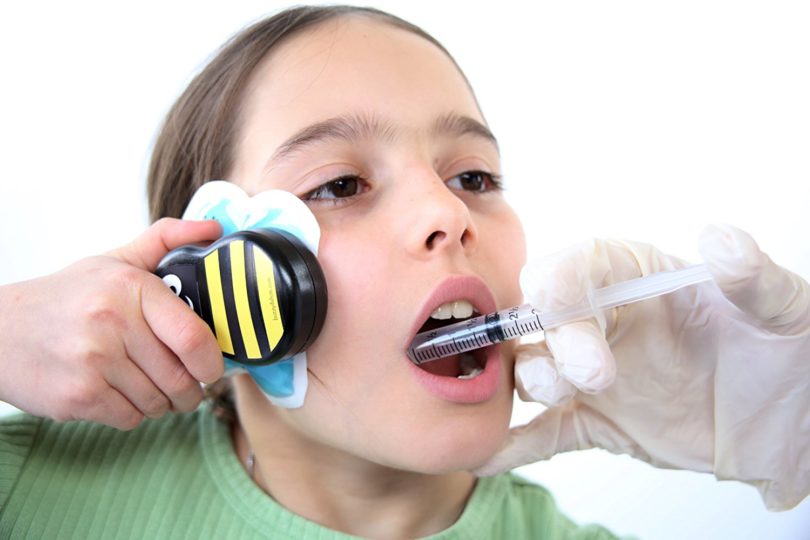The invention of a device that lessens the pain from needle sticks goes back more than a decade, when Dr. Amy Baxter was getting her then 4-year-old son ready for a shot.
Baxter, a pediatric emergency doctor, had prepared a few tricks–numbing cream in place, distraction techniques ready–but the nurse ignored it all and stuck her son without warning.
That didn’t sit well with Baxter.
“If I can’t control my own kid’s pain, and I’m in the system, how about everyone else?” she wondered.
In her quest to come up with a solution, Baxter landed on the idea of using a device that combined vibration with cold. The combination of the sensations, she theorized, would distract the brain from the pain of a needle.
And so Buzzy was born
Buzzy is the name for a yellow-and-black, palm-sized vibrating device that, when combined with an ice pack and held against the skin before a shot, eliminates or lessens the pain from a needle.
The device with the unconventional name (Baxter’s son came up with it) operates on the medical concept of “gate control,” where only the strongest sensations make it through the “gate” of the brain. The separate sensations of vibration and icy cold reach the brain first, so the pain from a shot is stopped. Basically, the cold and vibration confuse the body’s nerves.
“Cold and vibration work,” says Baxter. “It’s physiologic and it makes sense.”
In the eight years since its launch, Buzzy’s effectiveness has been backed by studies and trials. To date, some 85,000 Buzzies have made their way into homes and medical facilities across the country. They’re particularly welcomed among those who get needle sticks regularly, including children living with chronic diseases such as diabetes and juvenile arthritis.
One study, done at Children’s Hospital of Philadelphia, found that the process of doing a blood draw or starting an IV on a child normally took an average of 40.5 minutes. Using Buzzy, the process took three minutes.
Baxter eventually stopped practicing medicine to focus on the Atlanta-based company she founded, MMJ Labs, which produces Buzzy. In 2014, she appeared on the television show Shark Tank, which showcases aspiring entrepreneurs. While the judges at Shark Tank liked her product, they didn’t think she was charging enough for it and didn’t think she should market it to individuals.
Now for use at home
Buzzies for home use (there are mini and larger versions) cost between $40 and $60. Distributors don’t really want to carry them because they’re so inexpensive, Baxter says, but being able to keep the cost low in order to help families is one of her driving forces.
I didn’t quit practicing medicine to do something that wouldn’t help people,” Baxter says. “We’re trying to keep the price low enough for families to afford them.
And so news of Buzzy mostly gets around by word of mouth, such as in parent communities on social media that are dedicated to childhood illnesses. That’s how Erin Freel heard about it.
Freel, who lives in Anchorage, Alaska, decided to give Buzzy a try when giving injections to her son, who was diagnosed with juvenile arthritis in 2015. Connor, 11, gets weekly injections of the chemo drug methotrexate and biweekly shots of the biologic Humira.
“The first time we did his methotrexate shot with Buzzy, he was like, ‘That was it?’” Freel says.
Freel brings Buzzy along to doctors’ offices and uses it to help her younger son with vaccines. She also let a friend who was getting blood thinner injections every day try it. The friend found that Buzzy helped ease her anxiety over the shots, so she got one of her own.
Baxter is a big believer in letting people play a part in managing their own pain by using any option available to them. Needle phobia because of pain is real–studies show that there’s been a rise in needle phobia since 1983, correlating to the rise in the number of childhood vaccines. One study showed that 63 percent of children said they were afraid of needles, according to a 2012 article published in the journal Vaccine.
Fear of needles is not just kid stuff
Needle phobia can continue into adulthood. A 2012 study commissioned by Target Corp. found that 23 percent of people reported not getting flu vaccines because of needle fear.
Taking the pain away, Baxter says, takes some of the fear away. Freel has seen it work in her son.
“Anything we can do to spare him pain, we do,” Freel says. “That’s why we use Buzzy. I can’t take away the burning in his joints. I can’t take away the feeling of stepping on burning glass. But I can take away the pain of a shot.”
Buzzies are now used in most children’s hospitals in certain departments, such as in rheumatology and emergency rooms. Some practitioners at The Children’s Hospital of the King’s Daughters in Norfolk, Virginia, use Buzzy. According to CHKD spokeswoman Sharon Cindrich, there are quite a few of them throughout the hospital.
There are anecdotes of people using Buzzy in other ways–from helping with the pain of removing a splinter to getting relief from achy muscles. So Baxter and her company created another product to help with chronic and everyday pain. Using the same theory as Buzzy, the product, VibraCool, is massaging ice therapy that can be strapped to the body to help with stiff and sore muscles and joints. Released last year, VibraCool is already being used by spas and physical therapists.
“We have so many stories where we changed somebody’s life,” Baxter says. “If I can uncouple pain and fear and empower patients to control their own pain, then I will have completed a life’s work.”



